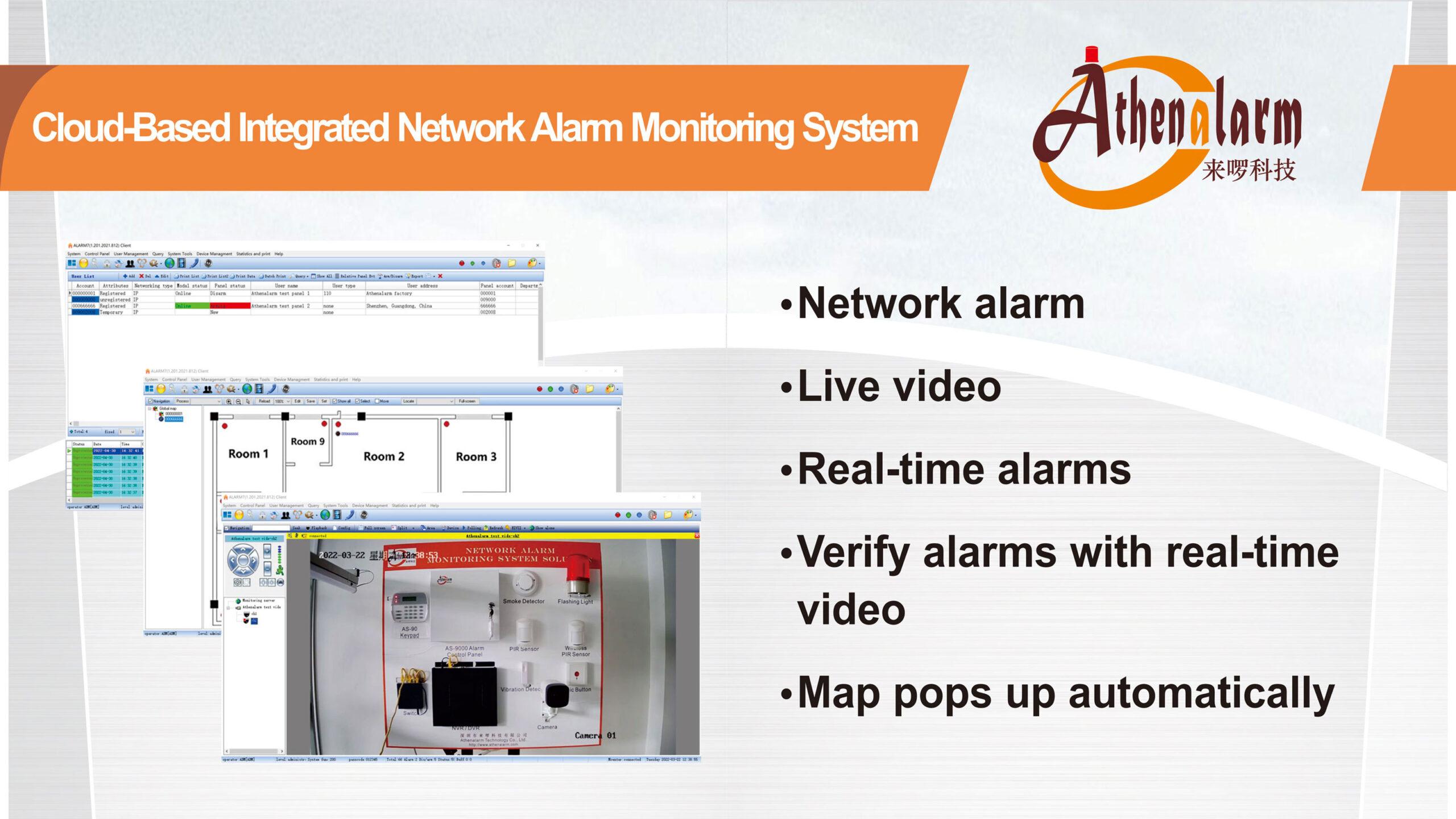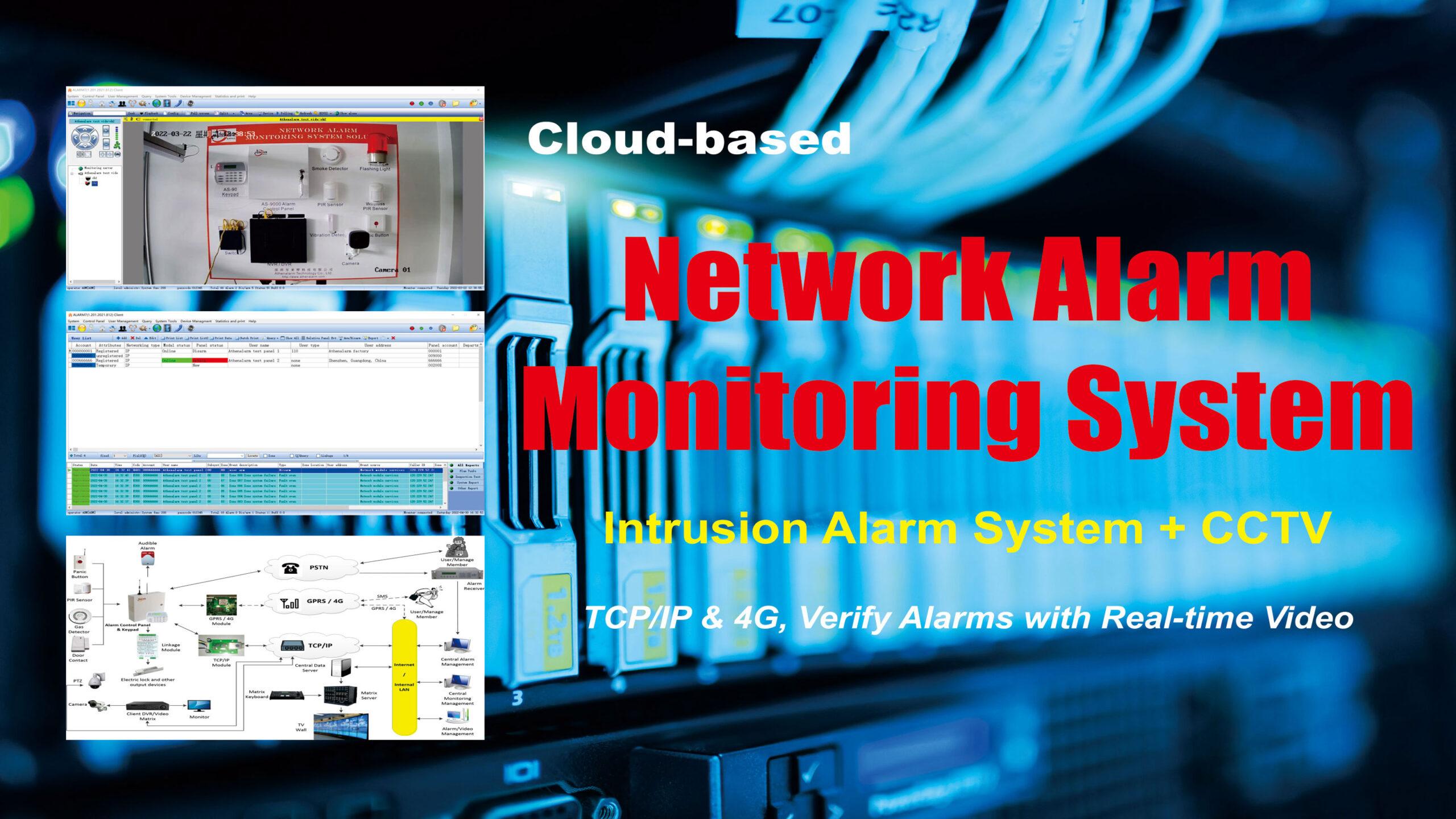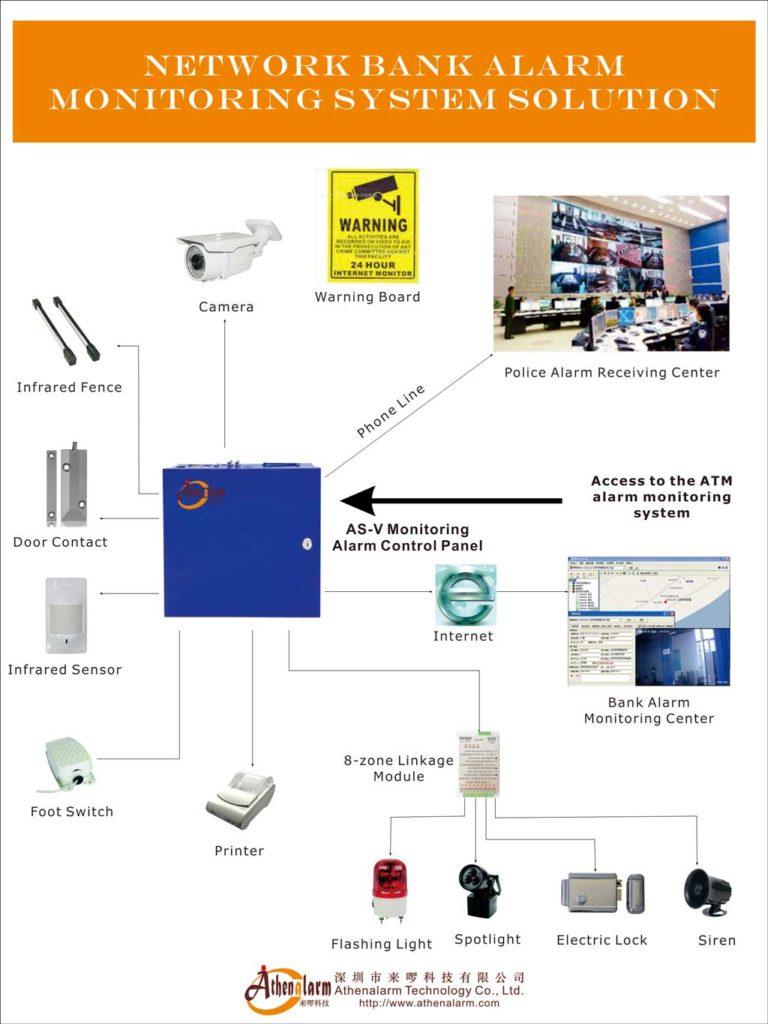



The Problems and Solutions of Bank Security Systems

1 Problems in the bank security systems
At present, major banks have basically installed relatively complete security systems. In addition to the monitoring system, they have also installed the intrusion alarm system, access system, etc. However, these security systems all have the following issues:
(1) The monitoring systems of most banks are in a disconnected state, working independently from the head office to branches, and various business outlets. There is no connection between the monitoring systems, and unified supervision cannot be achieved.
(2) Some bank monitoring systems are also based on simple DVR networking, but there are still the following issues:
- Failure to achieve centralized management and unified authorization
- Unable to guarantee simultaneous monitoring and real-time performance from multiple points
- The recording is still unclear
- Retrieval is still very difficult
- High dependence on manual labor at the alarm monitoring center
(3) In addition to the monitoring system, other bank security subsystems also work independently and cannot achieve effective linkage, resulting in a large number of false alarms and missed alarms.
(4) The images captured by surveillance cameras are usually in CIF format, and their clarity, color realism, and effective image size cannot meet the monitoring requirements of banks.
Due to the above issues, the bank security systems have been unable to meet the needs of bank security management.
2 Solutions to bank security systems
As we mentioned earlier, the current situation of most banks is that there is basically no internet connection, and even those that have internet connection are still based on DVR, which still has many problems.
How to network to meet the needs of bank security management? We believe that networking must be achieved through a management platform, and as a bank network management platform, it must have the following characteristics:
(1) Supports high-definition, compatible with standard definition
The main purpose of monitoring system is to see the monitored target clearly, so the first issue to be solved is the clarity of the image. At present, there are more and more high-definition front-end cameras on the market, such as megapixel, 720P/1080P and other standard high-definition cameras, and many high-definition cameras have added technologies such as ultra wide dynamic technology, high-speed and high sensitivity ExmorCMOS technology, visibility enhancement technology, infrared night vision technology, etc., greatly improving the level of front-end video acquisition.
In addition to providing higher resolution images, high-definition cameras also have a wider monitoring field of view. Previously, several standard definition cameras were needed inside the bank counter, but now only one high-definition digital camera needs to be installed to view several bank counter workstations. So it’s easy for us to think of improving the clarity of monitoring images by simply replacing the front-end camera with a high-definition one.
However, in reality, simply high-definition the front-end of the monitoring system is clearly not enough, and all aspects of the monitoring system must be high-definition. This is like watching high-definition digital TV at home. The TV station provides high-definition video programs as a prerequisite, but it also requires the support of the TV and network. The monitoring system also follows this principle. The front-end, network, and management platform (storage, forwarding, decoding, display, client) of the entire system must support high-definition.
Considering the cost of high-definition and other issues, we believe that it is unrealistic to achieve full high-definition overnight at all branches. Standard definition and high-definition will coexist for a long time and gradually achieve high-definition. This requires all aspects of the platform to achieve high standard definition compatibility. As the current end devices gradually switch from standard definition to high-definition cameras, the platform devices do not need to be replaced. Simply expand and upgrade the network according to the increase in the number of front-end devices.
(2) Compatible with mainstream brand front-end devices
Due to historical reasons, the monitoring systems of banks have been gradually built in batches, resulting in numerous front-end devices involved in the bank security systems, including various brands of DVR/DVS/NVR//IPC. This requires the management platform to have strong compatibility. It is not realistic to be compatible with all these devices for display, but at least it should be able to be compatible with mainstream front-end devices, such as DVR/DVS/NVR/IPC on the market.
(3) Adapt to the bank security management needs
Functionally speaking, the management platform should also be able to adapt to the bank security management needs in order to serve them better.
According to the investigation, there are three main lines of bank security management, namely cash as the main line, duty time and events as the main line, and alarm situation handling as the main line. So, starting from this perspective, the principle of our monitoring system is that where cash is, the focus of monitoring should be located. For example, at 2 am, if cash is in the bank vault, self-service bank, and ATM machine, then the focus of our monitoring should be on the bank vault, ATM machine, and self-service bank. At 10 am, cash is mainly in various business outlets, and our monitoring focus will mainly be on the business outlets. From 7 am to 9 am, cash is transported out of the bank vault by cash trucks and then sent to various business outlets. Therefore, the focus of monitoring at that time was on the payment process of the bank vault, cash trucks, and business outlets. Taking the cash truck as an example, when the cash truck transports the cash box to the branch, the monitoring system should pay attention to the environment of the cash truck to see if there are other cars occupying the dedicated parking space of the cash truck, and if there are any suspicious people outside the branch. When receiving cash, check whether all commuting doors are open, and do the staff comply with regulations when receiving cash. The focus of monitoring cash flow also changes at different periods. When an alarm occurs, the relevant images pop up to the designated location. For example, when an ATM alarm occurs, the alarm signal is transmitted to the alarm monitoring center through the network, and then the alarm linkage and processing are carried out based on the type of alarm and the pre-set linkage, such as the display of associated cameras, the pop-up of electronic map.
In addition, with the deepening of bank security systems, the relationships between various departments of banks are also becoming more and more profound. Previously, the technology department of the bank was closely related to the business department, while the security department was closely managed by the bank security systems. But with the development of networking, there will be a trend of integration between the technology and security departments of banks in the future, with more integration between business systems and security systems. The management of professional conduct and discipline is currently a hot topic in application. Taking bank tellers as an example, as the window for dialogue between banks and customers, disputes are most likely to arise. The same camera can both see counter staff and capture customers. This type of transaction process not only provides video materials and legal basis for possible transaction disputes and other economic criminal activities, but also provides management materials to ensure that business processes are standardized.
To uncover the business management characteristics of these banks, it is necessary to reflect them on the management platform. For example, if a bank focuses on cash, the management platform will also use it as the main line to automatically pop up the location image of cash on the TV wall at different periods, which makes it convenient for bank security personnel to monitor. Increase monitoring and management of cash transport vehicles and escort vehicles, and integrate GIS geographic information systems and GPS positioning systems to facilitate monitoring of cash transport vehicles. Provide interfaces to business systems of bank security systems for business supervision.
(4) Equipped with a multi-level cascading architecture
From the perspective of platform structure, the management platform must have a multi-level networking architecture, because from the perspective of bank management architecture, usually the first level provincial head office, the second level city branch office, the third level district/county branches, and various subordinate business outlets. Therefore, it is required that our management platform has the ability of multi-level networking, can flexibly achieve multi-level networking, and carry out unified permission management, in order to adapt to the requirements of multi-level networking management from top to bottom for banks.
(5) High reliability
The scale of bank security systems is very large, which requires the management platform to have high reliability. For example, the core management equipment should have the function of dual host standby to prevent the problem of the entire system crashing when a device or the network connected to it fails. The platform equipment should have the function of a multi machine cluster. When any one of them fails, other devices in the cluster can replace and complete the work tasks of the faulty server. From an architectural perspective, it is also necessary for all levels of networked platforms to operate independently, and any failure or disconnection of one level of platform will not affect the operation and use of other levels of platforms.
(6) Provide rich and easy-to-use operating functions
The management platform also needs to have rich and easy-to-use functions to solve many problems of a single platform based on DVR networking, such as:
- To achieve unified authorization through the management platform
- Ensure simultaneous monitoring from multiple points on the management platform with almost no latency
- Supports multi-level electronic maps, which can be used to call video images on the map. When an alarm occurs, the map where the alarm point is located will automatically pop up and be displayed in red flashing
- The alarm monitoring center can initiate voice intercom with the branch, and vice versa, the branch can also initiate a request for intercom with the alarm monitoring center
- Patrol the working status of the equipment. If there is any abnormality in the monitoring equipment, the video of the hard disk recorder is lost, the network is disconnected, the power is cut off, or the UPS power is depleted, it should be automatically uploaded to the alarm monitoring center
- Provide an easy-to-use retrieval mode, including recording by time, location, event, etc., which can be flexibly set on the front-end DVR or back-end management platform. Unified retrieval is based on all DVRs and front-end devices of the entire system
(7) Integrate other security systems
There are many security systems in banks, but they work independently of each other, forming information silos. For example, when an alarm occurs, there is a high possibility of false alarms due to the lack of image correlation. When an alarm actually occurs, there is a possibility of false alarms due to only a single alarm system working. This requires a centralized management platform to achieve unified management of multiple security systems. So the first and foremost task falls on the alarm monitoring management platform, which integrates other security systems to achieve complex linkage with alarm systems, fire protection systems, access systems, and other systems, thereby building a network alarm monitoring management platform for security systems. When there is an alarm, there is an image, and any event can be traced back to the recorded footage, greatly reducing the frequency of system false alarms and missed alarms, and reducing reliance on manpower.
(8) Adapt to existing network environment
At present, due to network and cost considerations, the scale of networking is mainly limited by the bandwidth of various levels of networks, and the bandwidth used for video networking between levels is not large. This requires the management platform to have extensive adaptability to the network, meeting the real-time and clarity requirements for video image transmission under low bandwidth conditions. In this case, networking mainly uses storage on the local DVR, selecting key images or storing relevant images on the higher-level platform during linkage alarm. Real time monitoring is usually displayed in a rotating manner on the higher-level platform based on the bandwidth size. When the network and cost are further improved, the scale of bank networking will inevitably expand. New branches will abandon DVR and directly use management platform equipment and digital high-definition cameras. A multi-level network alarm monitoring management platform can be built from the higher-level city branch to the provincial head office.
(9) Introducing intelligent analysis technology
When bank alarm monitoring system is connected to the internet, the scale of the system further expands. It is obvious that relying solely on human labor to monitor 24 hours in the alarm monitoring center with the naked eyes cannot meet the needs of bank security. Therefore, we believe that it is necessary to introduce some intelligent technologies. They include real-time intelligent analysis (IVS) and post intelligent retrieval technology. We believe that the biggest demand for real-time intelligent analysis in banks is to use IVS to monitor unmanned ATM machines to prevent criminals from installing magnetic card readers at the entrance or on the ATM machine to steal the depositor’s card number, and install pinhole cameras to peek at the depositor’s password. By using IVS, the locations where these illegal devices may be installed are monitored. Once the above events occur, an alarm will be triggered and relevant personnel will be notified. At the same time, the automatic doors on site will be locked to facilitate the police’s capture of criminals. The intelligent retrieval of post incident videos is mainly to provide fast operational tools for the police to solve cases after the incident. After a case occurs, it often requires a lot of manpower to search for useful clues from a large number of video recordings. Generally speaking, for every case solved, it is necessary to view hundreds or even thousands of hours of video footage. Relying solely on manpower is often inefficient and prone to errors and omissions, resulting in missing the golden time to solve the case. The post event intelligent retrieval function is equivalent to using machines to view and filter videos, achieving the effect of improving the efficiency of video viewing. The principle is to analyze large segments of video recordings through pre-processing set conditions, and then present effective recordings of vehicles, people, and other moving objects passing through designated positions for further examination by investigators based on the conditions. A large number of invalid segments are discarded, greatly speeding up the viewing time of the recordings and providing an effective way to search for clues in solving cases.
3 Summary
With the development of bank security systems to this day, in order to better security management, networking is necessary. The simple networking based on DVR is obviously outdated, and only networking through management platforms is the correct way. This poses certain requirements for the management platform:
Firstly, it is required that the management platform be compatible with high standard definition, mainstream front-end devices on the market, and integrate with other bank security systems.
Secondly, it is required that the management platform should adapt to the multi-level management of banks from top to bottom in terms of architecture, have high reliability, be able to adapt to the network environment of banks, and provide rich and easy-to-use operational functions.
Finally, the alarm monitoring system also needs to introduce some intelligent technologies and be able to integrate with banking business.
